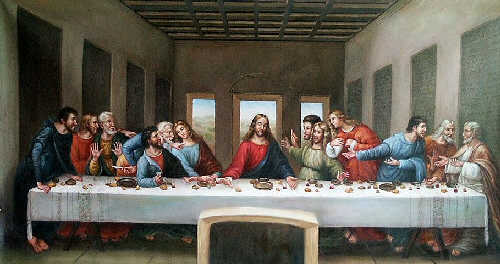|

|
The Last Supper
|
In The Da Vinci Code, Leigh Teabing uses The Last Supper to illuminate his lecture on the Holy Grail and coded references to it in Western art, literature, and history. Teabing notes a variety of strange characteristics about the canvas-the feminine figure of Mary Magdalene, normally considered to be St. John, seated to Christ's right, the disembodied dagger pointing threateningly at Mary, the chalice and M symbols drawn by the bodies of Mary and Jesus.
The painting measures 460 × 880 centimeters (15 feet × 29 ft) and can be found in the back halls of the dining hall at Santa Maria delle Grazie in Milan, Italy. The theme was a traditional one for refectories, but Leonardo's interpretation gave it much greater realism and depth. The lunettes above the main painting, formed by the triple arched ceiling of the refectory, are painted with Sforza coats-of-arms. The opposite wall of the refectory is covered by a Crucifixion fresco by Donato Montorfano, to which Leonardo added figures of the Sforza family in tempera. (These figures have deteriorated in much the same way as has The Last Supper.) Leonardo began work on The Last Supper in 1495 and completed it in 1498-however, he did not work on the piece continuously throughout this period.
The Last Supper specifically portrays the reaction given by each apostle when Jesus said one of them would betray him. All twelve apostles have different reactions to the news, with various degrees of anger and shock.
From left to right:
Bartholomew, James, son of Alphaeus and Andrew form a group of three, all are surprised.
Judas Iscariot, Peter and John form another group of three. Judas is wearing green and blue and is in shadow, looking rather withdrawn and taken aback by the sudden revelation of his plan. He is clutching a small bag, perhaps signifying the silver given to him as payment to betray Jesus, or perhaps a reference to his role within the 12 disciples as treasurer. He is not the only person to have his elbow on the table, the painting also shows Jude Thaddeus with his elbow on the table, traditionally a sign of bad manners. Peter looks angry and is holding a knife, pointed away from Christ; perhaps foreshadowing his violent reaction in Gethsemane during Jesus' arrest. The youngest apostle, John, appears to swoon.
